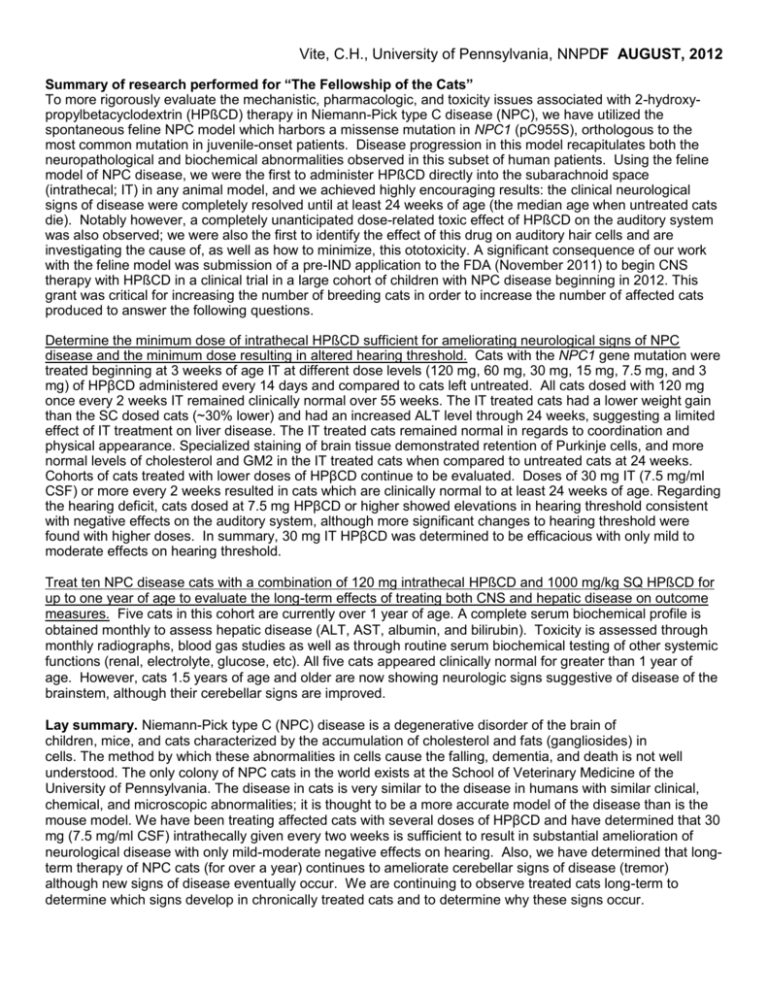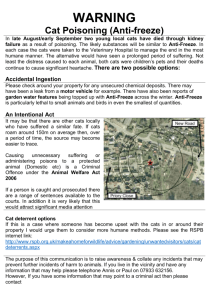August 2012 Progress Summary - National Niemann
advertisement

Vite, C.H., University of Pennsylvania, NNPDF AUGUST, 2012 Summary of research performed for “The Fellowship of the Cats” To more rigorously evaluate the mechanistic, pharmacologic, and toxicity issues associated with 2-hydroxypropylbetacyclodextrin (HPßCD) therapy in Niemann-Pick type C disease (NPC), we have utilized the spontaneous feline NPC model which harbors a missense mutation in NPC1 (pC955S), orthologous to the most common mutation in juvenile-onset patients. Disease progression in this model recapitulates both the neuropathological and biochemical abnormalities observed in this subset of human patients. Using the feline model of NPC disease, we were the first to administer HPßCD directly into the subarachnoid space (intrathecal; IT) in any animal model, and we achieved highly encouraging results: the clinical neurological signs of disease were completely resolved until at least 24 weeks of age (the median age when untreated cats die). Notably however, a completely unanticipated dose-related toxic effect of HPßCD on the auditory system was also observed; we were also the first to identify the effect of this drug on auditory hair cells and are investigating the cause of, as well as how to minimize, this ototoxicity. A significant consequence of our work with the feline model was submission of a pre-IND application to the FDA (November 2011) to begin CNS therapy with HPßCD in a clinical trial in a large cohort of children with NPC disease beginning in 2012. This grant was critical for increasing the number of breeding cats in order to increase the number of affected cats produced to answer the following questions. Determine the minimum dose of intrathecal HPßCD sufficient for ameliorating neurological signs of NPC disease and the minimum dose resulting in altered hearing threshold. Cats with the NPC1 gene mutation were treated beginning at 3 weeks of age IT at different dose levels (120 mg, 60 mg, 30 mg, 15 mg, 7.5 mg, and 3 mg) of HPβCD administered every 14 days and compared to cats left untreated. All cats dosed with 120 mg once every 2 weeks IT remained clinically normal over 55 weeks. The IT treated cats had a lower weight gain than the SC dosed cats (~30% lower) and had an increased ALT level through 24 weeks, suggesting a limited effect of IT treatment on liver disease. The IT treated cats remained normal in regards to coordination and physical appearance. Specialized staining of brain tissue demonstrated retention of Purkinje cells, and more normal levels of cholesterol and GM2 in the IT treated cats when compared to untreated cats at 24 weeks. Cohorts of cats treated with lower doses of HPβCD continue to be evaluated. Doses of 30 mg IT (7.5 mg/ml CSF) or more every 2 weeks resulted in cats which are clinically normal to at least 24 weeks of age. Regarding the hearing deficit, cats dosed at 7.5 mg HPβCD or higher showed elevations in hearing threshold consistent with negative effects on the auditory system, although more significant changes to hearing threshold were found with higher doses. In summary, 30 mg IT HPβCD was determined to be efficacious with only mild to moderate effects on hearing threshold. Treat ten NPC disease cats with a combination of 120 mg intrathecal HPßCD and 1000 mg/kg SQ HPßCD for up to one year of age to evaluate the long-term effects of treating both CNS and hepatic disease on outcome measures. Five cats in this cohort are currently over 1 year of age. A complete serum biochemical profile is obtained monthly to assess hepatic disease (ALT, AST, albumin, and bilirubin). Toxicity is assessed through monthly radiographs, blood gas studies as well as through routine serum biochemical testing of other systemic functions (renal, electrolyte, glucose, etc). All five cats appeared clinically normal for greater than 1 year of age. However, cats 1.5 years of age and older are now showing neurologic signs suggestive of disease of the brainstem, although their cerebellar signs are improved. Lay summary. Niemann-Pick type C (NPC) disease is a degenerative disorder of the brain of children, mice, and cats characterized by the accumulation of cholesterol and fats (gangliosides) in cells. The method by which these abnormalities in cells cause the falling, dementia, and death is not well understood. The only colony of NPC cats in the world exists at the School of Veterinary Medicine of the University of Pennsylvania. The disease in cats is very similar to the disease in humans with similar clinical, chemical, and microscopic abnormalities; it is thought to be a more accurate model of the disease than is the mouse model. We have been treating affected cats with several doses of HPβCD and have determined that 30 mg (7.5 mg/ml CSF) intrathecally given every two weeks is sufficient to result in substantial amelioration of neurological disease with only mild-moderate negative effects on hearing. Also, we have determined that longterm therapy of NPC cats (for over a year) continues to ameliorate cerebellar signs of disease (tremor) although new signs of disease eventually occur. We are continuing to observe treated cats long-term to determine which signs develop in chronically treated cats and to determine why these signs occur.





